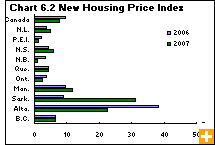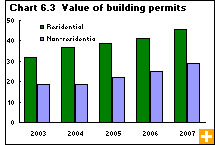Common menu bar links
Construction
Archived Content
Information identified as archived is provided for reference, research or recordkeeping purposes. It is not subject to the Government of Canada Web Standards and has not been altered or updated since it was archived. Please contact us to request a format other than those available.
Construction is one of Canada’s largest industries, essential to the nation’s economic health and prosperity. There are more than 260,000 Canadian construction firms, more than 65,000 in residential construction and 150,000 in trades contracting.
The construction industry remained relatively strong in 2007 despite some market factors exerting significant downward pressure, particularly a sluggish U.S. economy and the higher value of the Canadian dollar.
In 2007, construction added $76.9 billion to Canada’s gross domestic product (GDP). Construction generated 20.4% of the GDP of goods-producing industries, and 6.3% of all industries. Evidence of its importance to the overall economy: the construction industry’s annual GDP growth rate since 2002 has consistently outpaced goods-producing industries and all industries.
However, the industry is starting to feel the impact of adverse market conditions. Construction’s GDP growth rate was 3.8% in 2007 compared with 2006 when it rose 8.1%. Each of the three construction industries—residential building construction, non-residential building construction, and engineering, repair and other construction activities—has seen similar pattern of continuous annual growth since 2003, followed by deceleration from 2006 to 2007.
The value of building permits—governmental permissions for the construction of new buildings or improvements to existing structures—is one important measure of the construction industry’s overall health. In 2007, the value of building permits rose 12.2% over 2006 to $74.4 billion. This growth was fuelled by demand in Ontario and Quebec, as well as in the booming urban centres of Western Canada. In Ontario, the value of building permits gained 14.7% to $26.7 billion; in Quebec it grew 9.2% to $13.0 billion. Saskatchewan’s gain of 44.6% was the largest percentage of growth by far among all provinces. Alberta saw a 13.4% increase in the value of building permits, and British Columbia, 8.7%.
Also a leader in employment growth
In 2007, construction recorded 5.9% employment growth, stronger than any other goods-producing industry except utilities. Construction employed 1,133,500 people in 2007. Employment has grown at least 5% each year since 2003.
This growth has put pressure on the supply of qualified construction workers. The workforce has generally managed to adapt to the higher demand, though shortages have sometimes forced contractors to delay or scale back activities. The age profile of the construction labour force remains a concern, as there is a growing need to replace skilled laborers who are nearing retirement age.
Investment in new homes
The Canadian economy began to slow in the last quarter of 2007, even though the country’s housing market remained robust throughout the year. Positive factors such as strong employment, rising incomes and relatively low mortgage rates drove the growth in residential construction.
Spending on new single-family housing increased 10.5%, and on apartment or condominium construction, 14.0% in the fourth quarter of 2007 compared with the fourth quarter of 2006.
Housing starts were brisk in 2007, at 228,343 units, up slightly from 2006. New housing investment advanced 8.7% to $43.3 billion. This increase was mainly due to investments in single-family homes, which rose 7.3% to $27.4 billion, and in apartment and condominium construction, which gained 9.7% to $10.3 billion. Among the provinces, the largest dollar increases came in Alberta and in Quebec.
Rising prices for new homes continued to push up new housing investment. According to the Canada Mortgage and Housing Corporation (CMHC), in December 2007, the average house price in census metropolitan areas increased to $439,860, up 12% from the previous December. In Toronto, the average price in December was $682,551, up slightly from $650,666 in December of 2006. In Calgary and Edmonton, prices rose in December to averages of $467,889 and $426,512 respectively, while the average price in Vancouver increased to $862,780. The lowest average price of a new home in a metropolitan area was in Moncton, $171,064.
Renovations
Canadians undertook $37.0 billion worth of renovations in 2007, accounting for 42% of all residential construction investment. This was a 10% increase from $33.7 billion in 2006.
According to CMHC’s Renovation and Home Purchase Survey, 37% of homeowner households in 10 of Canada’s major centres renovated their primary residence in 2007. This was down from 39% in 2006. The share of households that renovated was the largest in Winnipeg (44%), Halifax (43%), St. John’s (42%), and Ottawa (40%); Calgary and Québec (35%) had the lowest share of household renovations in 2007.
Non-residential construction
Thanks largely to huge gains in office building construction in Alberta and British Columbia, investment in non-residential building construction set a seventh consecutive annual record in 2007. Investment in commercial, industrial and institutional projects hit $39.5 billion, up 12.3% from 2006.
Western Canada’s robust economy continued to play a part. Alberta and British Columbia accounted for more than 75% of the increase in non-residential investment nationally. In both provinces, commercial projects dominated investment. Contributing factors were low vacancy rates for office buildings, strong consumer demand for durable goods and high corporate profits, in particular for banks and the oil and gas industry.
The value of non-residential building permits was $28.8 billion in 2007, up 14.4% from 2006. Ontario and the booming western provinces of Saskatchewan and Alberta showed the highest increases in dollars, and together these three provinces accounted for almost 65% of the total value of non-residential building permits in Canada. Permits for commercial construction rose 17.6% to $17 billion; building permits for industrial construction went from $4.5 billion to $5.0 billion, a 10% jump.





